Dog breeds with corded coats always turn heads at any dog show or event. They’re often covered with ropes of hair that may reach the floor, and many wonder what it takes to create and maintain this unusual coat style.
But first, just what are these ropes of hair? The correct term for them is “cords” and they’re long strands of interwoven hair with a core of live hair, but no breed is born corded. The soft puppy coat tends to fall into very short cords that may be obscured by the sometimes “lumpy-looking fluff” on its outer ends. Cords are the product of many hours of meticulous care and cleanliness, but no brushing or combing.
Cording requires a coat that’s long and a bit curly. Generally, corded coats appear on breeds said to have hair rather than fur. Some AKC-recognized corded breeds include the Bergamasco Sheepdog, Havanese, Komondor, Poodle, Puli, Pyrenean Shepherd, and Spanish Water Dog. Here’s why these dogs have historically corded coats.
Komondor

The Komondor is today’s poster dog for corded breeds. A full-coated adult may sport floor-length tresses of mop-like white cords that even cover its face. The Komondor worked as a Hungarian flock guard. Their untended coat formed large mats that not only made it look like a sheep to unsuspecting predators, but also protected against predator bites.
The AKC Komondor standard states that the adult Komondor should be entirely covered with a heavy coat of tassel-like cords that are felt-like to the touch. It explains that the cords form naturally because the dog’s course, wavy or curly outer coat traps the soft wooly undercoat, which forms the cords. The breed standard also cautions judges not to penalize a younger dog for having short cords, as their length depends on their age.
Puli
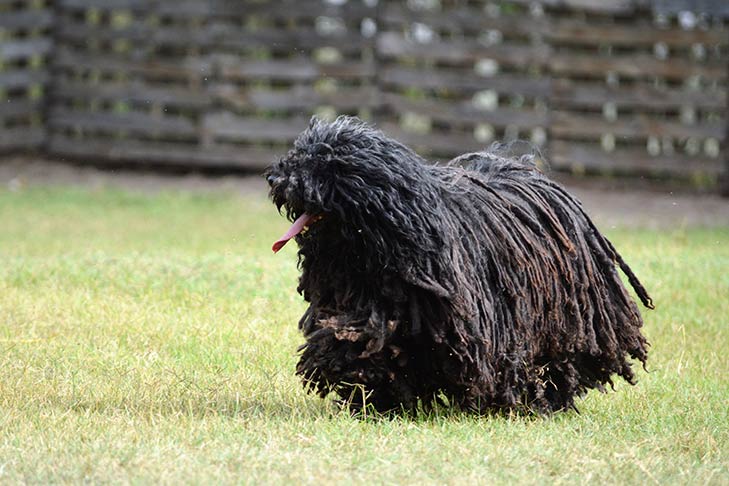
Smaller than the Komondor, the Puli is the other breed people often think of when they think of corded breeds. Their coat can be a variety of solid colors. The Puli was bred as a herding dog, so it had to be active and energetic. A working Puli was often shorn, so they only had cords on their rear end. Unlike the Komondor, the Puli can be shown either corded or brushed out. Most adults are shown corded.
The AKC Puli breed standard describes their cords as “wooly, varying in shape and thickness, either flat or round.” The cords are wooly, varying in shape and thickness, either flat or round. Their coat’s shape and thickness depend “on the texture of the coat and the balance of undercoat to outer coat.” Although the standard allows for the breed to be shown brushed out, this is far less common today than when the Puli was first shown in North America. Fanciers explain that’s because few had the correct texture for cording in those early days, but now the texture has improved.
Bergamasco Sheepdog
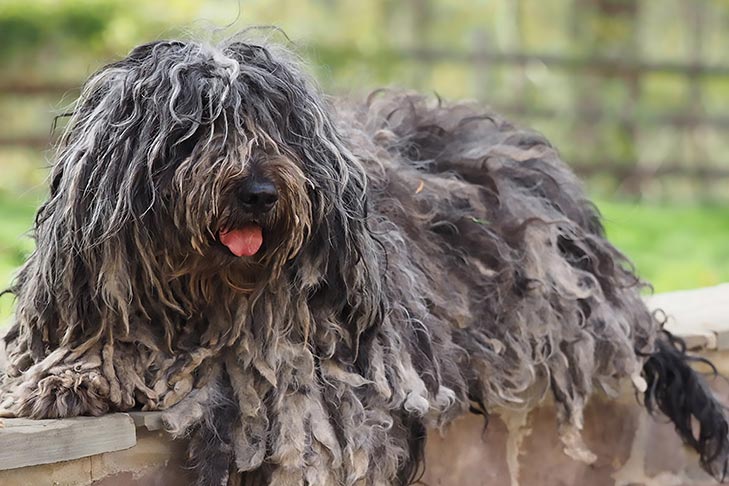
Unlike the Komondor’s perfect cords, the Bergamasco has a type of cording called flocks. Unlike cords, flocks are irregularly large, flattened, and wide, measuring about 1.5″ to 3″ in width. Flocks may open to a fan at their ends. The overall picture is not one of orderly mop strands but of haphazard, individual clumps and tassels.
The Bergamasco’s hair is unique, and their coat consists of three types of hair: a wooly outer coat, a long, straight rough coat called “goat hair,” and a fine, oily undercoat. It’s the goat hair and outer coat that mostly make up the flocks. The flocks can reach almost to the ground in a fully mature dog.
The AKC Bergamasco Sheepdog breed standard explains that goat and woolly hair aren’t distributed equally over the body. That accounts for the difference in cords. For instance, goat hair predominates from the top of the head down through the upper back, resulting in less flock formation. On the remaining parts of the neck, shoulders, and chest, woolly hair predominates, causing more flocks. The majority of flocks occur on the back of the body and legs, where there’s mostly wooly hair.
Poodle

We think of Poodles as having perfectly coiffed bouffant hairdos, but did you know the first Champion Poodle in England had a corded coat? That was in the late 1800s, and Champion Achilles, as he was named, sported 30″ cords—longer than his 23″ height! Mentioned in the 1886 English standard for the Poodle, cords were once thought to be limited to a special kind of Poodle “curlies.” We now know that’s not true, although some Poodle coat types do cord better than others.
As fashions changed, corded Poodles all but disappeared. But they’ve made a slight comeback over the past few decades. Today’s corded Poodles have much shorter, more practical cords. Most corded Poodles are Standard Poodles, but the other two varieties can also be corded. Corded Poodle owners report that some colors are easier to cord than others.
The AKC Poodle standard says the cords should be tight and even, as well as measure varying lengths. The cords are longer on the mane or body coat, head, and ears, and they’re shorter on the puffs, bracelets, and pompons (rounded tufts of fur or hair). Corded Poodles must still be shown in one of the approved Poodle clips for the AKC ring. Most corded Poodles are shown in the Continental clip.
Havanese
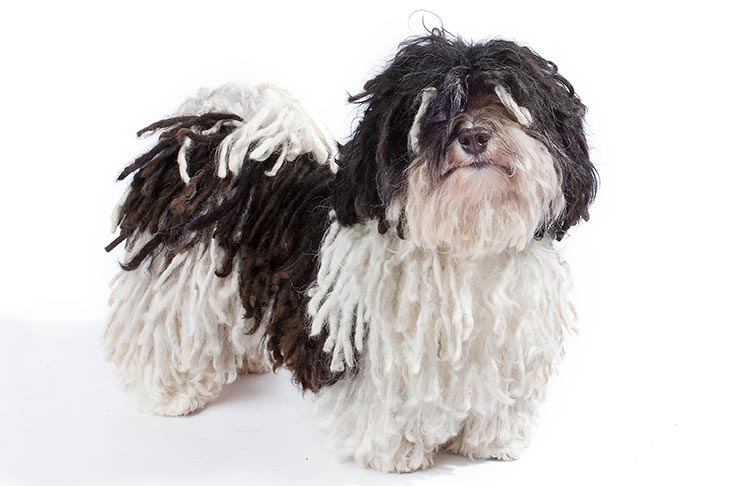
The Havanese is the smallest of the corded breeds and the only one in the Toy Group. Their long coat is naturally very lightweight and slightly wavy. It has a natural tendency to cord, but most Havanese are kept brushed out. Owing to their small size, they are probably the easiest of the breeds to maintain in cords.
The AKC Havanese standard states that adult corded Havanese should be completely covered with a full coat of tassel-like cords. However, this cannot be expected of young dogs, in whom the corded coats will naturally separate into wavy sections.
Spanish Water Dog
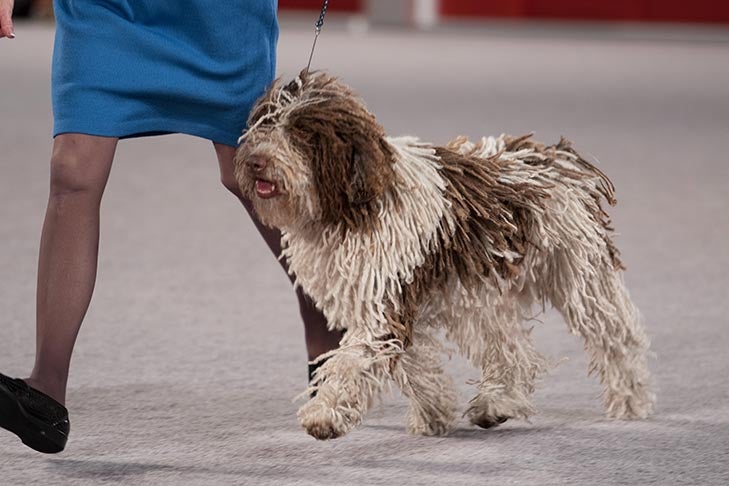
The Spanish Water Dog is AKC’s newest corded breed. This medium-sized dog was developed in Spain to herd all types of livestock, assist fishermen, and even help hunters in the field. This breed has a unique grooming requirement—the coat is supposed to be clipped down to about a quarter-inch in length all over once a year. Then, you can allow it to grow out. After that, you’re not supposed to brush it or comb the coat—just let it grow. After several months, the coat will start to cord in most areas, but it also mats in areas of friction, so it may need some attention to split mats into cords.
The AKC Spanish Water Dog standard describes their cords as “pencil-thin,” distinct from cords of other breeds in their degree of felting from loose to tight. Most interestingly, each cord should have a natural “fish-hook curl” at its tip. This is to indicate that the cords have not been scissored or shaped. Try to be patient with a youngster since most puppy coats will not form cords.
Pyrenean Shepherd

The Pyrenean Shepherd is an ancient herding dog. It’s an especially unique case, as it comes in two varieties, Rough-Faced and Smooth-Faced. The Rough-Faced comes in two hair lengths—long and demi-long. Only the Rough-Faced long coats tend to cord, often only on the flanks and rump. The Pyrenean Shepherd Club of America notes that the traditional name for the cords is “cadenettes.” These can be trained to fall into discreet cords, but otherwise tend to be flat and wide.
The AKC Pyrenean Shepherd standard describes how the demi-long and long-haired Rough-Faced dog’s cords differ. The demi-long dogs have culottes (long hair on the hind legs), while the long-haired dogs are more likely to cord more, especially on the elbows, croup, and thighs, but never on the head.
Cording Your Dog’s Coat
First, your dog should belong to one of these recordable breeds. If you try it with most other breeds, you’ll just end up with mats.
But if you do own one of these breeds, how hard is cording their coat? According to Poodle breeder Joe Genarella, who has corded dogs in almost all of these breeds, each breed is different. But this practice takes a lot of initial work. sometimes even several months.

“Cords are a system of controlled mats,” says Genarella. “You start when the dog still has puppy coat, and continuously split the mats into smaller pieces, integrating any frizzy hair that you might be tempted to remove. Leave it! That frizzy hair will come to coat the live hair within the cord, giving it a finished look.”
But that’s not all you need to do to produce a perfect cord. He explains the process involves a lot of repetitive wetting, drying, wetting, and drying of the cords in order to condense them. “Each time the cord gets soaked, it shrinks up a bit and gets more dense,” he says. “But then you have to dry it thoroughly because cords that are left wet can mildew.”
“It takes about a year to grow three- to four-inch cords in a Poodle,” Genarella says, “two years to not look neglected!” Once established, corded coats are in some ways easier, says Genarella. “You don’t have to keep brushing and combing all the time, or even clipping. But if you do need to shorten the cords, you’re going to need some strong scissors!”
Bathing and Caring for Corded Breeds
Bathing is a long process. First, you must carefully separate the cords before bathing by using your fingers to pull apart any new growth near the skin. Don’t use a mat splitter for this, as it cuts the hair and won’t leave the frizz needed to wrap around the cords.
Then, soak the dog in a tub for a half hour or so, which is how long it takes for water to penetrate the cords. Then add shampoo, taking care not to scrub at the cords. Rinsing also takes time, so be sure to use a product that you can easily rinse out.
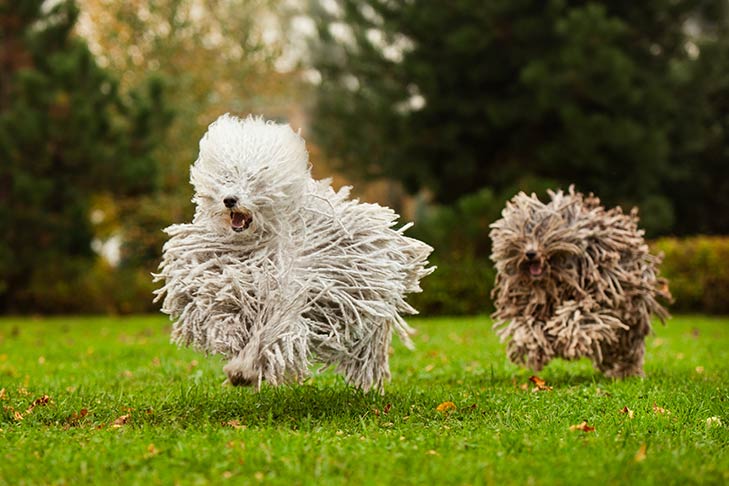
To dry your dog, use superabsorbent towels to blot as much moisture off as possible. Don’t scrub at them with a towel to get them to dry faster. Also, you shouldn’t let the cords air dry, as that can take up to 48 hours, depending on your climate, and this can cause the cords to mildew and smell. On the other hand, a strong blow dryer can cause the cords to fly around and tangle. Instead, a cage dryer is most commonly used, but these must be used with care, as dogs can overheat in them if they’re enclosed or left too long. Always use a timer and have an open space to let in fresh air.
Corded dogs can live active lives, but as with any long coat, it takes extra work if you plan to go hiking and swimming. In fact, Genarella advises against taking a fully corded dog swimming due to the weight of the wet cords. “The cords of a heavily corded dog can weigh 20 pounds or more,” he cautions.
Most corded dogs kept only as companions have their cords cut to just a few inches long. And they still look amazing!

